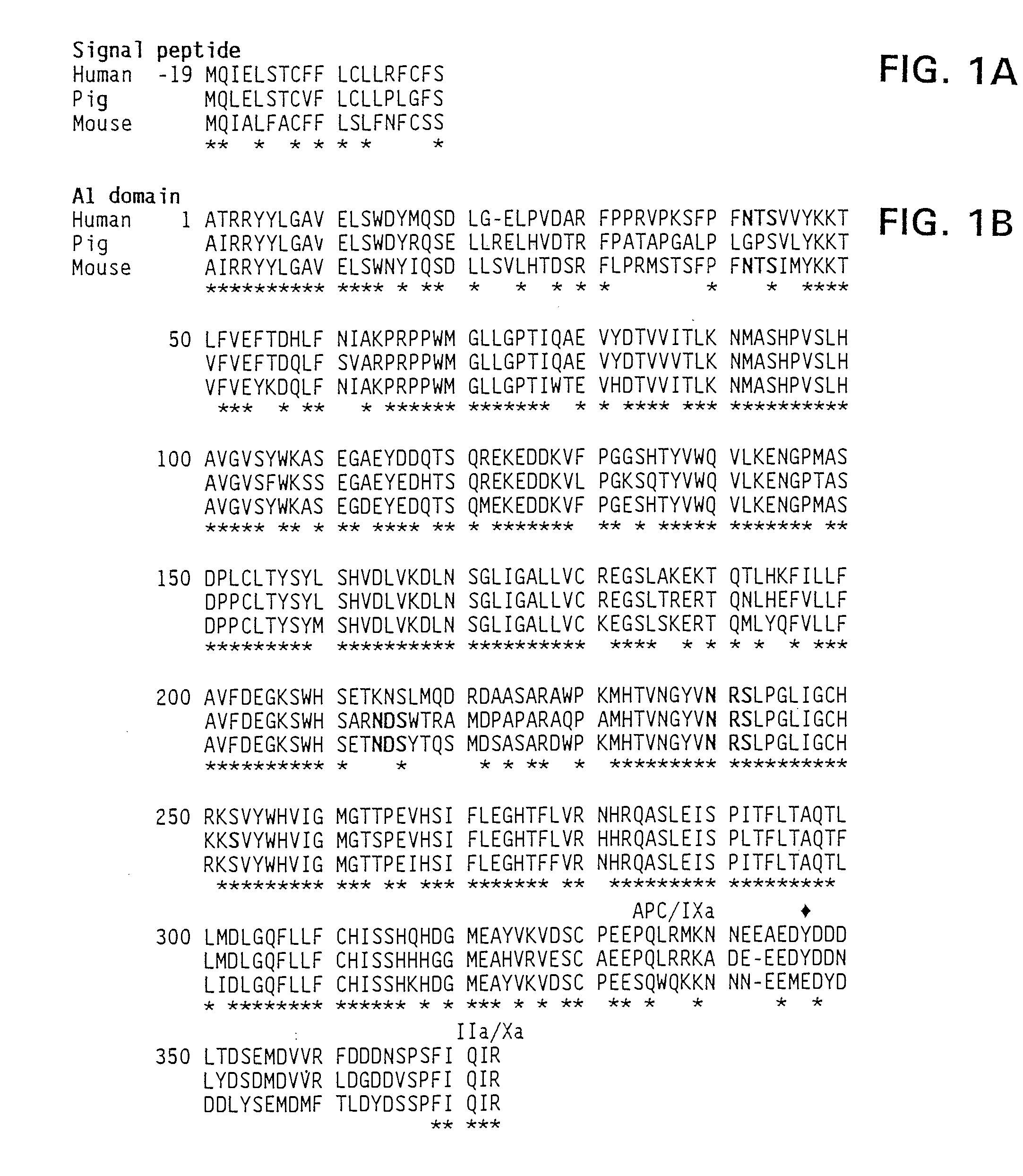Modified Factor VIII
a technology of hybrid factor and factor viii, applied in the field of hybrid factor viii, can solve the problems of antibody, serious symptoms, and serious complications, and achieve the effects of superior coagulant activity, superior coagulant activity, and superior coagulant activity
- Summary
- Abstract
- Description
- Claims
- Application Information
AI Technical Summary
Benefits of technology
Problems solved by technology
Method used
Image
Examples
example 1
Assay of Porcine Factor VIII and Hybrid Human / Porcine Factor VIII
[0144] Porcine factor VIII has more coagulant activity than human factor VIII, based on specific activity of the molecule. These results are shown in Table III in Example 4. This conclusion is based on the use of appropriate standard curves that allow human porcine factor VIII to be fairly compared. Coagulation assays are based on the ability of factor VIII to shorten the clotting time of plasma derived from a patient with hemophilia A. Two types of assays were employed: the one-stage and the two stage assay.
[0145] In the one-stage assay, 0.1 ml hemophilia A plasma (George King Biomedical, Inc.) was incubated with 0.1 ml activated partial thromboplastin reagent (APTT) (Organon Teknika) and 0.01 ml sample or standard, consisting of diluted, citrated normal human plasma, for 5 min at 37° C. in a water bath. Incubation was followed by addition of 0.1 ml 20 mM CaCl2, and the time for development of a fibrin clot was dete...
example 2
Characterization of the Functional Difference Between Human and Porcine Factor VIII
[0148] The isolation of porcine and human plasma-derived factor VIII and human recombinant factor VIII have been described in the literature in Fulcher, C. A. et al. (1982) Proc. Natl. Acad. Sci. USA 79:1648-1652; Toole et al. (1984) Nature 312:342-347 (Genetics Institute); Gitschier et al. (1984) Nature 312:326-330 (Genentech); Wood et al. (1984) Nature 312:330-337 (Genentech); Vehar et al. 312 Nature 312:337-342 (Genentech); Fass et al. (1982) Blood 59:594; Toole et al. (1986) Proc. Natl. Acad. Sci. USA 83:5939-5942. This can be accomplished in several ways. All these preparations are similar in subunit composition, although there is a functional difference in stability between human and porcine factor VIII.
[0149] For comparison of human recombinant and porcine factor VIII, preparations of highly-purified human recombinant factor VIII (Cutter Laboratories, Berkeley, Calif.) and porcine factor VIII...
example 3
Comparison of the Stability of Human and Porcine Factor VIII
[0152] The results of the one-stage assay for factor VIII reflect activation of factor VIII to factor VIIIa in the sample and possibly loss of formed factor VIIIa activity. A direct comparison of the stability of human and porcine factor VIII was made. Samples from Mono Q™ HPLC (Pharmacia, Inc., Piscataway, N.J.) were diluted to the same concentration and buffer composition and reacted with thrombin. At various times, samples were removed for two-stage coagulation assay. Typically, peak activity (at 2 min) was 10-fold greater for porcine than human factor VIIIa, and the activities of both porcine and human factor VIIIa subsequently decreased, with human factor VIIIa activity decreasing more rapidly.
[0153] Generally, attempts to isolate stable human factor VIIIa are not successful even when conditions that produce stable porcine factor VIIIa are used. To demonstrate this, Mono Q™ HPLC-purified human factor VIII was activat...
PUM
| Property | Measurement | Unit |
|---|---|---|
| Volume | aaaaa | aaaaa |
| Volume | aaaaa | aaaaa |
| Volume | aaaaa | aaaaa |
Abstract
Description
Claims
Application Information
 Login to View More
Login to View More - R&D
- Intellectual Property
- Life Sciences
- Materials
- Tech Scout
- Unparalleled Data Quality
- Higher Quality Content
- 60% Fewer Hallucinations
Browse by: Latest US Patents, China's latest patents, Technical Efficacy Thesaurus, Application Domain, Technology Topic, Popular Technical Reports.
© 2025 PatSnap. All rights reserved.Legal|Privacy policy|Modern Slavery Act Transparency Statement|Sitemap|About US| Contact US: help@patsnap.com



